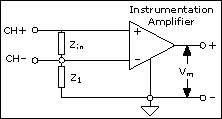Pseudodifferential Measurement System
A pseudodifferential measurement system combines some characteristics of a differential input channel and a referenced single-ended (RSE) input channel. Like a differential input channel, a pseudodifferential measurement system exposes both the positive and negative sides of the channel. You connect the positive and negative inputs to the respective outputs of the unit under test. The negative input is tied to system ground through a relatively small impedance (designated as Z1 in the diagram below). The impedance between the negative input and ground may include both resistive and capacitive components. The positive and negative sides of the input channel are separated by a larger impedance (designated by Zin).
Pseudodifferential input configurations are common in simultaneous sampling and dynamic signal acquisition (DSA) devices that do not employ a multiplexed signal architecture. A pseudodifferential system is well-suited for measuring the output of floating or isolated devices under test such as battery-powered instruments or most accelerometers. The pseudodifferential setup can also be used to measure referenced signals if the signal reference potential does not differ greatly from the ground potential of the measurement device. However, ground loops may pose an issue if the potential of the negative leg of the signal differs significantly from chassis ground. In general, a differential input offers a better common-mode rejection ratio (CMRR) than a pseudodifferential input.
